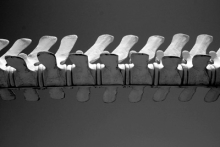Making the Numbers Fit the Fossils

Penn Arts and Sciences Magazine: Spring/Summer 2012 issue
by Mark Wolverton
photo by Kai Schreiber
The discovery of DNA and subsequent development of molecular biology offered a new method for paleontologists to study the echoes of the past. By analyzing the DNA sequences of present-day organisms, they could trace back the ancestral history stored in species' genetic code and infer patterns of diversity and extinction. Molecular phylogeny analysis promised to fill in gaps in the fossil record where good specimens hadn't yet been found.
But, according to Joshua B. Plotkin, Associate Professor of Biology and Computer and Information Science, "There has been a growing rift between fossil-based and molecular-based inferences of species diversity trends over time." The glaring problem is that, while molecular phylogenetic analysis invariably indicated ever-increasing diversity in every species, "the fossil record clearly shows extinctions and long periods of diversity loss."
Plotkin and his colleagues, in work originated by postdoctoral fellow Hélène Morlon, have developed a new approach to resolve these nagging inconsistencies. They began by examining one of the most complete fossil species records available: the cetaceans (whales, dolphins and porpoises). The cetacean fossil record, about 35 million years old and remarkably well-preserved, shows a peak of species diversity about 10 million years ago with about 150 species, diminished to 89 present-day species.
Previously, phylogenetic techniques incorrectly predicted ever-increasing diversity for cetaceans. Plotkin, Morlon and postdoctoral fellow Todd Parsons took a new approach to a newly published set of cetacean molecular DNA data from 87 of the 89 currently extant species. Their method included variables not considered in previous phylogenetic techniques, such as allowing for variable rates of diversification and taking into account different clades (groups of organisms sharing similar characteristics) separately.
Using these refinements, Plotkin and his colleagues found that the history of cetacean diversity inferred from DNA sequences was remarkably consistent with the fossil record, in both the rates of speciation and extinction. They show that most present-day cetaceans arose from four recent radiations (diversification from a single ancestor), as is reflected by the actual fossil samples.
The work represents a major step in solving one of paleontology's most troubling conundrums. While there's little chance that sophisticated mathematical modeling is going to put pick-wielding field paleontologists out of business anytime soon, Plotkin notes that models like this have the potential to offer "a more detailed view of the history of biological diversity on earth than fossils have been able to provide." At the same time, Plotkin acknowledges that there are limitations to the technique. For example, to be effective, it requires a great amount of DNA data—data that just aren't yet available for some forms of life.
In the meantime, there are many questions to be answered. It remains to be seen how the method developed by Plotkin's group will perform in analyzing the phylogenies of other species. And, Plotkin notes, "The steps we've taken so far are simply to help reconstruct the pattern of species diversity through time. What remains is to understand the causes of these patterns."
Even as he continues to study such questions, Plotkin remains entranced by the possibilities of this line of work. "We've attempted to reconstruct the history of species diversity in whales, some of the largest creatures ever to exist on earth … and we've relied on comparing the DNA molecules isolated from organisms today," he says. "It's still amazing to me that it's possible to learn anything about such massive creatures going back so far in time, using only microscopic DNA samples from today."





